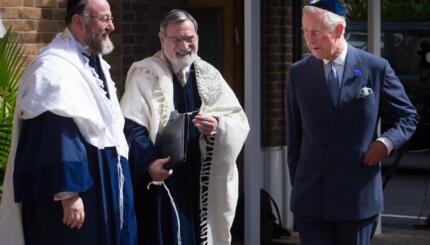Jewish institutions have demonstrated a commitment to addressing the issue of Jewish continuity with a variety of outreach program meant to provide Jewish individuals, non-Jewish individuals interested in learning more about Judaism, and families (including interfaith families) with rich and varied Jewish experiences that will draw them into Jewish life. The following article reports the results of a survey on the efficacy of such outreach programs. It is reprinted with permission from The Jewish Week.
Since the 1990 National Jewish Population Study found that just over half of those who had recently married wed non‑Jews, the organized Jewish community has been on an outreach spree.
As a result, outreach programs abound today. Synagogues, Jewish federations and educational organizations provide an extensive range of offerings to the intermarried, to the inmarried, to those who are marginally engaged with Jewish life, and to those who haven’t had any involvement since their parents stopped forcing them to attend Hebrew school right after their bar mitzvah.
 But what good have these programs done?
But what good have these programs done?

Help us keep Jewish knowledge accessible to millions of people around the world.
Your donation to My Jewish Learning fuels endless journeys of Jewish discovery. With your help, My Jewish Learning can continue to provide nonstop opportunities for learning, connection and growth.
A new study conducted by the Jewish Outreach Institute found that they increased the participants’ levels of Jewish interest and activity.
The study’s findings “once and for all let us put to rest any questions about outreach,” said Rabbi Kerry Olitzky, the institute’s executive director. “Outreach is efficacious, cost effective and should continue to be a priority for the Jewish community to ensure its vibrancy of the Jewish community for generations to come.”
While the conclusion may seem self‑evident, the survey of participants was the first to evaluate the outcome of a broad variety of these efforts, which have become a focus for much of the organized Jewish community as it struggles to deal with a constituency eroded by assimilation and intermarriage.
The JOI study asked participants in an array of programs–from those committed to multi-session Introduction to Judaism courses offered by synagogues to those who attended a one-shot Chanukkah party held in a mall–how their attitudes and behavior changed after outreach program involvement. On the whole, they were more involved and enthusiastic about Jewish endeavors after their program experience.
At the same time, the study’s research director, City University of New York sociologist Egon Mayer, said questions about attitudes toward conversion could not be included in the survey because the very word “conversion” has become too hot to handle.
Steven Bayme, national director of the Department for Contemporary Jewish Life for the American Jewish Committee, said the fact that the word can no longer even be used in discussions around outreach is a serious problem and symptomatic of how the culture has shifted. He blamed outreach programs for the change.
Still, the study found that programs aimed at engaging people with a range of backgrounds, including unaffiliated Jews and interfaith families, had more impact than programs targeting just interfaith couples. It also found that outreach programs have their greatest impact on people who are part of interfaith couples.
The study found as well that recreational programs, rather than those which are overtly educational, are more effective at reaching a larger number of people, said Mayer, founding director of the JOI.
Among the specific findings:
– While just under half of the respondents, 49 percent, went to synagogue “sometimes” or “frequently” before participating in an outreach program, the percentage jumped to 67 percent afterward. When the responses of those involved in interfaith relationships were separated out, the differences were even more striking: 33 percent went to synagogue before the program, 60 percent went afterward.
– Among intermarried respondents who had not joined a synagogue, 35 percent became members after program participation and another 25 percent were considering membership at the time of the survey.
– dinner was often enjoyed by 48 percent of respondents overall before they participated in an outreach program. That jumped to 69 percent afterward. Among interfaith couples, the number climbed from 35 percent who had Shabbat dinner on many Friday nights before participating in a program to 65 percent afterward.
– Most of the respondents, 86 percent, celebrated major Jewish holidays before the outreach program, but nearly all, 94 percent, did so afterward. Almost as many of the interfaith involved, 83 percent, did so beforehand, and again, 94 percent did so afterward.
– Less than half of the respondents overall, 46 percent, were involved with Jewish cultural activities before participating in an outreach program, which rose to 62 percent afterward. Among those in interfaith relationships, less than one‑third, 32 percent, had attended Jewish film festivals, Jewish museums and the like before the outreach program, but 51 percent said that they did afterward.
The JOI, founded in 1987, is a New York‑based research and advocacy think tank devoted to outreach. In 1998 the institute also became a funder of outreach programs, administering money contributed by a coalition of foundations to 13 groups around the country. After three years of funding, JOI had granted $800,000 to the projects.
Two or more group’s programs never really got off the ground, so the survey was sent to 3,165 people who had participated in the outreach efforts of 11 groups. Twenty‑three percent of them responded to the survey, which got under way in January [2001].
What became clear to JOI executives as they designed the survey with input from program organizers is that the very vocabulary used in discussions about outreach has become fraught with tension.
The JOI questionnaire purposely avoided asking program participants about their attitudes toward conversion–for instance, if being involved in an outreach program had made them more or less interested in considering conversion.
That’s because the outreach program leaders wouldn’t allow the word “conversion” to be used, said Mayer.
“They said use the word ‘conversion’ and you’ve lost me half my people,” said Mayer. “We’d love to know certain things but we can’t ask because they’re viewed as ‘alienating.’
“Most of our grantees were extremely leery of us even making contact with their participants. They felt that these relationships are very delicate,” he said.
Bayme, a longtime critic of JOI’s work, opposes the idea that intermarriage should be regarded as completely acceptable.
In February [2001] he founded a coalition of like‑minded sociologists and academics. The challenge of developing consensus around the right approach toward intermarriage can be seen in the fact that the coalition has not yet been able to agree on a mission statement, or even a name.
Bayme lauded the new evaluation of outreach programs by JOI, though, and its finding that programs inclusive of everyone are more effective than those aimed at the intermarried alone. But he was dismayed by the fact that the idea of conversion had become too hot even to raise in the study.
“It used to be that the primary message [articulated by representatives of the Jewish community] was to endorse marriage within the faith. When that didn’t work, it became conversion,” Bayme said. “Now we’re being told you can’t even talk about conversion to Judaism.
“On the ground, it’s become just as difficult to speak on inmarriage as conversion. Notice then how it’s become such a slippery slope. The idea that Jews can’t talk about marriage within the faith or conversion to Judaism lest they give offense is much, much too high a price tag” to pay in order to do outreach, said Bayme.
Mayer said it’s too soon to assess the programs’ long‑term impact. “This is not the end of the story but the middle. The lasting value of these programs will have to be studied over and over again.”


